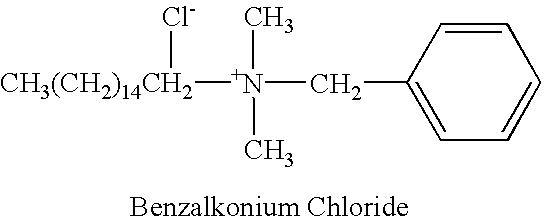Antimicrobial prevention and treatment of human immunedeficience virus and other infectious diseases
a technology for immune deficiency virus and antimicrobials, applied in the direction of drug compositions, plant/algae/fungi/lichens, immune disorders, etc., can solve the problems of non-infectious virus formation, rt inhibitors can interrupt this process, and viral structural proteins cannot be properly manufactured, etc., to achieve dramatic improvement in the effectiveness of antimicrobial drugs, good resolving (treatment), and unexpected and surprising antiviral activity
- Summary
- Abstract
- Description
- Claims
- Application Information
AI Technical Summary
Benefits of technology
Problems solved by technology
Method used
Image
Examples
examples 8-13
Dermatological and Veterinary Testing
[0102] Animal testing to determine any possible dermatological allergic reaction induced by the medical composition (medicine) was undertaken. Six animal subjects were used. The animals included 3 female rabbits (ages unknown); 2 dogs (1 female 2 year old, and 1 male 9 year old); one, 3 year old neutered male cat. In these animal tests, the above composition (medicine) was applied, in the previously stated method, to the inside of the outer ear of each animal. In all instances, the area being treated was kept coated with the compound for twenty-four hours, matching the time human subjects had used. The testing performed on the six animal subjects indicated that there were no signs of dermatological irritation or allergic reaction.
example 14
[0103] The above medical compound containing viral inhibitors was also tested on a papilloma virus caused wart on the muzzle of a two year old gelded thoroughbred horse. Papilloma virus warts are difficult to treat. The wart measured 25 mm in diameter. The antimicrobial compound (medicine) was applied twice daily. The wart was then measured at each application.
[0104] Results:
[0105] Quite unexpectedly, the wart decreased dramatically in size by approximately 3 mm per day while the medicine was applied to the wart and on the fifth day fell off completely. It was observed that, at first the surface layers of the wart began to degrade, exposing large erythematous papules. Then interestingly, the warts did not just diminish in size by flaking or peeling, they diminished at the point of attachment on the subject's epidermis and fell off still somewhat intact with no sequela scarring.
[0106] In an ongoing, long term in vivo study of this invention, which began with the first seven subjects ...
examples 15-17
[0114] In these in vitro tests, the following drugs (medicine) was used:
[0115] Drug # 1.=Benzalkonium chloride surfactant in an aqueous solution at a ratio of 1:750. The surfactant in the aqueous solution was filtered before use and diluted in an equal volume of 2.times. MEM to give a 1:1500 dilution in 1.times. MEM.
[0116] Drug # 2=Echinacea powder (photochemicals) in an aqueous solution. This preparation was extracted by warm infusion in sterile water. The extracted phytochemicals was centrifiged and filtered before use. The filtered phytochemicals were diluted in an equal volume of 2.times. MEM to give the undiluted preparation in 1.times. MEM.
[0117] Drug # 3=Echinacea powder (phytochemicals) were extracted and combined with benzalkonium chloride surfactant by a cold infusion process. The combined preparation was centrifuged and filtered before use and diluted in an equal volume of 2.times. MEM to give the undiluted preparation in 1.times. MEM.
[0118] 1. Three 24-compartment plates...
PUM
| Property | Measurement | Unit |
|---|---|---|
| Fraction | aaaaa | aaaaa |
| Fraction | aaaaa | aaaaa |
| Fraction | aaaaa | aaaaa |
Abstract
Description
Claims
Application Information
 Login to View More
Login to View More - R&D
- Intellectual Property
- Life Sciences
- Materials
- Tech Scout
- Unparalleled Data Quality
- Higher Quality Content
- 60% Fewer Hallucinations
Browse by: Latest US Patents, China's latest patents, Technical Efficacy Thesaurus, Application Domain, Technology Topic, Popular Technical Reports.
© 2025 PatSnap. All rights reserved.Legal|Privacy policy|Modern Slavery Act Transparency Statement|Sitemap|About US| Contact US: help@patsnap.com



